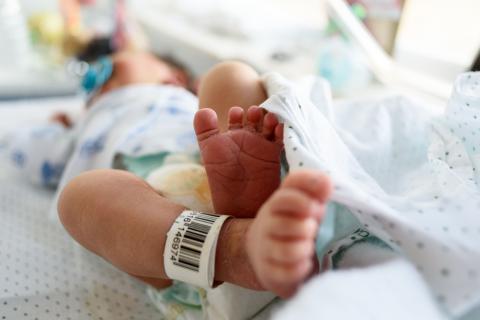Babies born through assisted reproduction have increased risk of serious heart defects, study finds
The relative risk of being born with a major heart defect is 36% in babies conceived using assisted reproductive techniques, such as in vitro fertilisation, compared to newborns not using these techniques, according to a study published in the European Heart Journal. The absolute risk was 1.84% versus 1.15%. The research, which included more than seven million babies born in Denmark, Finland, Norway and Sweden, also shows that the increased risk is especially associated with multiple births, which are more common in assisted reproduction.

Rocío Núñez - FIV cardio EN
Rocío Núñez Calonge
Scientific Director of the UR International Group and Coordinator of the Ethics Group of the Spanish Fertility Society
The increasing prevalence of infertility problems in the general population has led to a higher demand for assisted reproductive technologies (ART), which has raised more concerns about the health of children born through these techniques. One of the conditions most commonly associated with these techniques is heart disease. Congenital heart defects are the most frequent congenital defects and account for approximately 50% of all major congenital defects, affecting about 1%–2% of children in the general population. Heart defects are a major pediatric health issue and remain the leading cause of mortality from congenital defects.
Several studies have been published showing an association between congenital heart defects and assisted reproduction (Olson et al., 2005v; Liu et al., 2015). Gullo et al., in 2023, conducted a meta-analysis of 24 studies to examine the relationship between heart defects in children born through ART compared to spontaneous births. They found a slight risk of congenital heart disease in pregnancies conceived via assisted reproductive technologies compared to spontaneous pregnancies. However, they concluded that this risk is not clinically significant. Other studies, such as Wen et al., only link this condition to multiple pregnancies, and in some cases, no association was found (Rasouli et al., 2024).
The work by Sargisian et al., published today in one of the most prestigious medical journals, European Heart Journal, uses national data from four Nordic countries (Denmark, Finland, Norway, and Sweden) to evaluate the risk of major congenital heart defects in live-born children conceived through assisted reproductive technologies compared to children born after spontaneous conception.
This large population-based cohort study of 7.7 million live-born children includes 171,735 born through assisted reproductive technologies.
The main findings were that ART was associated with a higher risk of major congenital heart defects (CHD) and severe congenital heart disease in live-born children followed up to 1 year of age, compared to spontaneous conception (SC). Children born from multiple pregnancies had the highest risk of congenital heart disease, but ART was also associated with a higher risk in singleton fetuses. No significant difference was found between singleton fetuses born after intracytoplasmic sperm injection (ICSI) and in vitro fertilization (IVF) or between fresh and frozen embryo transfers.
Major congenital heart defects: diagnosed up to the first year in 3,159 children born after ART (1.84%) and in 86,824 children born after spontaneous gestation (1.15%). Severe congenital heart disease was detected in 594 children born after ART (0.35%) and in 19,375 children born after spontaneous births (0.26%).
Severe congenital heart disease was detected in 0.31% (n = 399) of singleton fetuses born after ART and in 0.25% (n = 18,539) of singleton fetuses born after spontaneous gestation. In multiple births after ART, the prevalence of severe congenital defects was 0.44%, compared to 0.43% in spontaneous births.
The main relationship with heart defects was pregestational diabetes.
The main strength of this study is the large population size, with data pooled at the national level and cross-referenced from several high-quality national registries. Additionally, the relationship between different assisted reproductive technologies and congenital heart disease was explored, and a very robust statistical analysis was employed.
However, there are some important limitations. First, confounding factors like maternal age and male infertility –previously linked by other authors to an increased risk of congenital heart disease– must be considered. Additionally, as the authors themselves mentioned in the study, the relationship found between heart defects and pregestational diabetes is noteworthy. However, the most important limitation is that, although the risk of major congenital heart disease is higher in children born after assisted reproductive therapy, Sargisian et al. acknowledge that the absolute increase in risk appears modest and therefore not clinically significant. In fact, the risk found in children born after ART, at 1.84%, does not exceed the general population risk, which is between 1% and 2%.
Despite this, this information should be conveyed to patients receiving counseling before undergoing assisted reproductive therapy. This study also highlights the importance of single embryo transfer to avoid the higher risks associated with multiple pregnancies.
Future studies should focus on the underlying infertility issues rather than the assisted reproductive techniques themselves to further explore any plausible relationships between these factors and congenital heart disease.
Yolanda Cabello - FIV cardio EN
Yolanda Cabello
Independent clinical embryologist and consultant in assisted reproduction and lecturer on the Master's Degree in Health and Clinical Management at the International University of Valencia
This study investigated congenital cardiac malformations in pregnancies obtained with different assisted reproductive technologies (ART). The sample is large, covering 171,735 children born after ART in several Nordic countries (Denmark, Finland, Norway and Sweden) from 1984 to 2015. The authors assessed how many live-born children were diagnosed with a major or severe heart defect in utero or during their first year of life. They took into account other factors that may increase the risk of congenital heart defects, such as the child's year of birth, country of birth, the mother's age at delivery, whether the mother smoked during pregnancy, or whether the mother had diabetes or heart defects.
The results showed that heart defects were more common in babies born after ART compared to those conceived without treatment (absolute risk of 1.84% vs. 1.15%). This risk was similar regardless of the type of ART (IVF or ICSI, fresh or frozen embryos). They also showed that the risk of ART births was higher for multiple births compared to singleton births (2.47% vs. 1.62%), which is to be expected and widely demonstrated, as the risk of malformations in multiple pregnancies is always higher than in singleton pregnancies, both in ART-born and naturally conceived children.
If we look at the latest European ART registry published in 2023, which reports the data recorded in 2019 by country, we can observe several curious things The number of clinics (registration is compulsory in these countries as well as in Spain) is 65 adding the 4 countries of the study and, only in Spain, it is 244. In our country there is a higher rate of multiple pregnancies than in the Nordic countries, a fact that has been the case for many years, since in these countries it is not allowed to transfer more than one embryo in most cases. Another striking fact is that in Spain 22,190 cycles of pre-implantation genetic screening are performed, while the sum of this type of cycles in the 4 countries of the study is 1,373, a fact that may be interesting due to the fact that genetically healthy embryos are selected before transferring them to the uterus of the future mother.
In 2013 we published a study in Spain from the Embryo Health Group which analysed 8,682 pregnancies obtained with ART and the neonatal malformations, prematurity and stillbirths in both single and multiple pregnancies of children born after these pregnancies. Malformations (not only cardiac, but all those classified according to the ICD 10 code of the WHO) were detected in 0.83 % of our newborns and there were no differences in malformations between single and multiple pregnancies, this percentage being similar to that of spontaneously conceived children.
I believe that the study should not be so alarmist, as there are no significant differences between children born after spontaneous pregnancies and those born after ART, especially since we are already starting from people with an infertility problem and who do not achieve pregnancy in a natural way. Prospective parents should be informed of the risks of the children born, as we do in our country, but without scaring them. Perhaps the Nordic countries should offer more pre-implantation genetic diagnosis techniques and do more genetic screening of patients before undergoing ART. It should be taken into account that the study has been done in countries with a low number of clinics, data on pregnancies from 1984 to 2015 have been analysed and there have been very significant changes in ART (improved conditions in IVF laboratories, culture media adapted to different situations, super-efficient cryopreservation techniques, improved embryo selection thanks to algorithms created after morphokinetic studies, implementation of quality systems, etc.) and that in Spain and other countries, the study has been done in countries with a low number of clinics, data on pregnancies from 1984 to 2015 have been analysed. ) and that in Spain and other countries the studies of malformations that have been carried out have not demonstrated higher rates of any malformation in children born with ART than in spontaneous pregnancies due to gamete manipulation techniques.
We are lucky to live in a country with one of the best pregnancy rates in Europe and proof of this is that half of the European cycles of oocyte donation or PGT are carried out here, as we are a leading country in reproductive tourism, thanks to a broad law on reproduction and the good professionals we have in this speciality in Spain.
Eva Bermejo - FIV cardio EN
Eva Bermejo
Director and Research Scientist at the Institute for Rare Diseases Research (IIER), Carlos III Health Institute (ISCIII)
The study addresses an important problem, both because of the wide use of assisted reproduction techniques and because congenital heart disease is one of the most frequent congenital defects. It is a large, mutivariate study, methodologically correct, in which multiple comparisons have been made with the necessary adjustments and considering possible statistical confounding factors. The authors have acknowledged limitations that they have taken into account in the discussion of their results and in drawing conclusions.
The importance of this work lies in the fact that it provides evidence that can help, on the one hand, to inform couples who resort to assisted reproductive techniques to achieve a pregnancy, since, in this way, the information will be based on objective data and, considering that the magnitude of the risk identified is quite discrete, it can be reported without unnecessarily alarming. On the other hand, the results reinforce the recommendation to transfer a single embryo in order to avoid multiple gestations, which are also known to carry an increased risk for birth defects. Furthermore, the data provided can be taken into account in prenatal diagnostic studies during gestational follow-up.
Is the study of good quality? Yes, the sample size is large, covering several countries over a long period, multivariate logistic regression analysis has been performed, with different comparison groups, and a number of variables relevant to the relationship studied have been taken into account in the adjustments as possible statistical confounders. On the other hand, in the discussion, limitations have been acknowledged which, without doubt, have to be taken into account in the interpretation of the results, as the authors have done’.
Are the absolute risks statistically significant? Yes, although in this case the adjusted risks are more interesting than the absolute risks, and the adjusted risks are also statistically significant, although the magnitude of the risk obtained is not very high.
What would you highlight from the research? It is an interesting study that adds evidence about the increased risk of major, severe congenital heart defects resulting from the use of assisted reproductive techniques. Given the relatively frequent use of assisted reproductive technologies, it is important that couples are informed about this and other known risks. Since the magnitude of the increase in risk that has been identified is quite discreet, this is a fact that should be emphasised when informing these couples to avoid unfounded alarm. On the other hand, given that the risks identified have been associated in part with multiple gestations, this finding reinforces the now widespread recommendation to perform single embryo transfers, as opposed to the more common practice in the past when multiple embryo transfers were routinely performed. The data obtained are also important for prenatal diagnosis, which can be directed in these pregnancies to specifically rule out congenital heart defects, although as these are among the most frequent prenatal developmental defects, they are already routinely screened for.
Are there any notable limitations? The inability to include data on stillbirths and terminations after prenatal detection of fetal anomalies has been recognised by the authors as a limitation of the study. This fact may lead to an underestimation of the risk for this type of congenital defects, since, being severe structural defects, they are usually well identified prenatally, which results in a higher number of terminations of pregnancy for this reason (which could not be taken into account) and, therefore, a lower number of affected newborns, this being the sample analysed.
Sargisian et al.
- Research article
- Peer reviewed
- People



